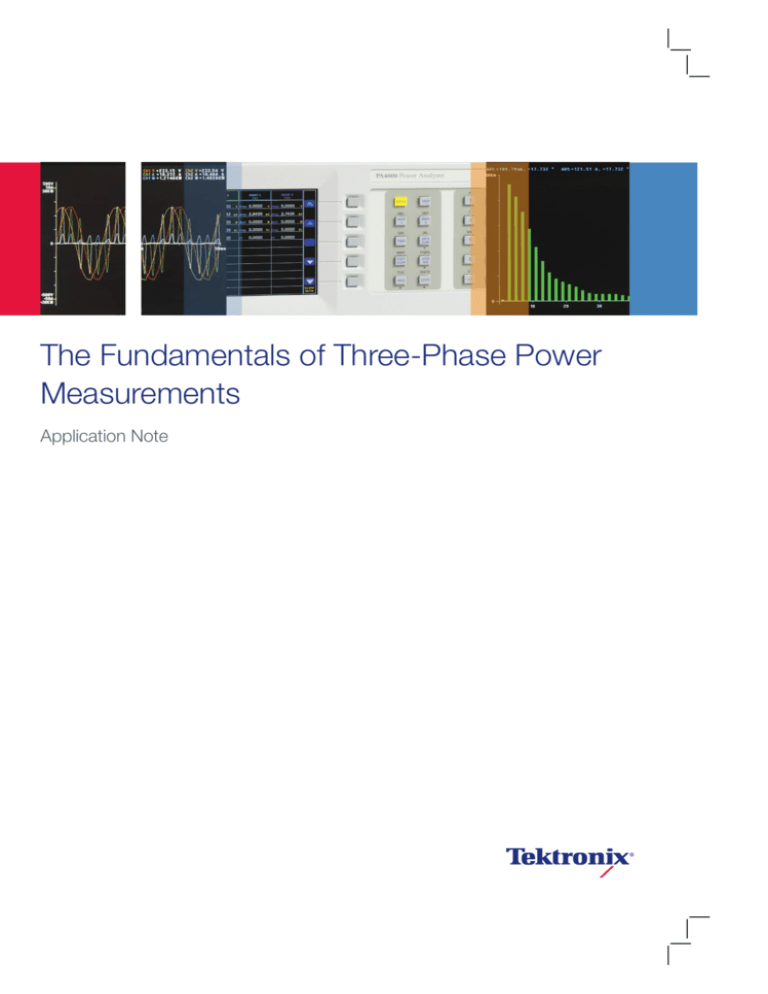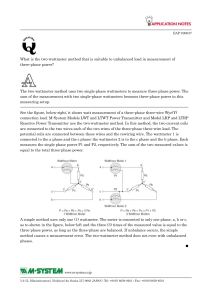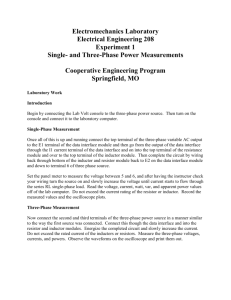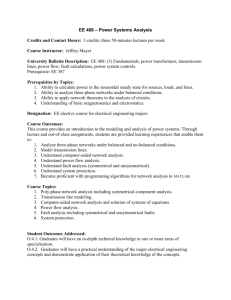
The Fundamentals of Three-Phase Power
Measurements
Application Note
Application Note
v1
0°
120°
v1
v3
v2
240°
N
360°
v3
v2
Figure 1. Three-phase voltage waveform.
v1
Figure 2. Three-phase voltage vectors.
1A
1A
1A
100Ω
1A
1A
v1
v2
v3
v3
100Ω
1A
Figure 4. Three-phase supply, balanced load - 3 units of loss.
1A
Three phase systems are used for two reasons:
100Ω
1A
Figure 3. Three single-phase supplies - six units of loss.
Introduction
Although single-phase electricity is used to supply common
domestic and office electrical appliances, three-phase
alternating current (a.c.) systems are almost universally used to
distribute electrical power and to supply electricity directly to
higher power equipment.
This technical note describes the basic principles of threephase systems and the difference between the different
measurement connections that are possible.
Three-phase systems
Three-phase electricity consists of three ac voltages of
identical frequency and similar amplitude. Each ac voltage
‘phase’ is separated by 120° from the other (Figure 1). This
can be represented diagrammatically by both waveforms and
a vector diagram (Figure 2).
2
v2
1A
www.tektronix.com/poweranalyzer
1.The three vector-spaced voltages can be used to create a
rotating field in a motor. Motors can thus be started without
the need for additional windings.
2.A three-phase system can be connected to a load such
that the amount of copper connections required (and thus
the transmission losses) are one half of what they would
otherwise be.
Consider three single-phase systems each supplying 100W
to a load (Figure 3). The total load is 3 x 100W = 300W. To
supply the power, 1 amp flows through 6 wires and there are
thus 6 units of loss. Alternatively, the three supplies can be
connected to a common return, as shown in Figure 4. When
the load current in each phase is the same the load is said to
be balanced. With the load balanced, and the three currents
phase shifted by 120° from each other, the sum of the current
at any instant is zero and there is no current in the return line.
In a three-phase 120° system, only 3 wires are required to
transmit the power that would otherwise require 6 wires. One
half of the copper is required and the wire transmission losses
will be halved.
The Fundamentals of Three-Phase Power Measurements
v1
v2
v1
v3
v2
0°
120°
360°
240°
N
v1+v2+v3=0
v3
Figure 6. The sum of the instantaneous voltage at any time is zero.
Figure 5. Wye or star connection - three- phase, four wires.
1A
Wye or Star Connection
1A
A three-phase system with a common connection is normally
drawn as shown in Figure 5 and is known as a ‘wye’ or ‘star’
connection.
1A
The common point is called the neutral point. This point is
often grounded at the supply for safety reasons. In practice,
loads are not perfectly balanced and a fourth ‘neutral’ wire is
used to carry the resultant current. The neutral conductor may
be considerably smaller than the three main conductors, if
allowed by local codes and standards.
Figure 7. Delta connection - three-phase, three wires.
Delta Connection
The three single-phase supplies discussed earlier could also
be connected in series. The sum of the three 120° phase
shifted voltages at any instant is zero. If the sum is zero, then
both end points are at the same potential and may be joined
together. The connection is usually drawn as shown in Figure
7 and is known a delta connection after the shape of the
Greek letter delta, Δ.
www.tektronix.com/poweranalyzer
3
Application Note
v1
Sin60° = 23
HI
A
LO
3
2
N
HI
V
CH1
N
LO
L
HI
V
or
CH1
LO
N
LO
A
LOAD
L
60°
LOAD
CH1
HI
CH1
v3
v2
Figure 8. V phase-phase = √3 x V phase-neutral
N
120V
120V
Figure 9. Delta configuration with a "split-phase" or "center-tapped" winding.
Wye and Delta Comparison
The Wye configuration is used to distribute power to everyday
single-phase appliances found in the home and office. Singlephase loads are connected to one leg of the wye between line
and neutral. The total load on each phase is shared out as
much as possible to present a balanced load to the primary
three phase supply.
The wye configuration can also supply single or three-phase
power to higher power loads at a higher voltage. The singlephase voltages are phase to neutral voltages. A higher phase
to phase voltage is also available as shown by the black vector
in Figure 8.
The delta configuration is most often used to supply higher
power three-phase industrial loads. Different voltage
combinations can be obtained from one three-phase delta
supply however, by making connections or ‘taps’ along the
windings of the supply transformers. In the US, for example, a
240V delta system may have a split-phase or center-tapped
winding to provide two 120V supplies (Figure 9). The centertap may be grounded at the transformer for safety reasons.
208V is also available between the center tap and the third
‘high leg’ of the delta connection.
4
www.tektronix.com/poweranalyzer
Figure 10. Single-phase, two-wire and DC measurements.
Power Measurements
Power is measured in ac systems using wattmeters. A modern
digital sampling wattmeter, such as any of the Tektronix power
analyzers, multiplies instantaneous samples of voltage and
current together to calculate instantaneous watts and then
takes an average of the instantaneous watts over one cycle
to display the true power. A wattmeter will provide accurate
measurements of true power, apparent power, volt-amperes
reactive, power factor, harmonics and many others over a
broad range of wave shapes, frequencies and power factor. In
order for the power analyzer to give good results, you must be
able to correctly identify the wiring configuration and connect
the analyzer's wattmeters correctly.
Single-Phase Wattmeter Connection
Only one wattmeter is required, as shown in Figure 10. The
system connection to the voltage and current terminals of
the wattmeter is straightforward. The voltage terminals of the
wattmeter are connected in parallel across the load and the
current is passed through the current terminals which are in
series with the load.
Single-Phase Three-Wire Connection
In this system, shown in Figure 11, the voltages are produced
from one center-tapped transformer winding and all voltages
are in phase. This is common in North American residential
applications, where one 240 V and two 120V supplies
are available and may have different loads on each leg. To
measure the total power and other quantities, connect two
wattmeters as shown in Figure 11.
S
an
The Fundamentals of Three-Phase Power Measurements
HI
A
LO
Blondel's Theorem:
Number of Wattmeters Required
L
HI
V
In a single-phase system there are just two wires. Power is
using a single wattmeter. In a three-wire system,
two wattmeters are required as shown in Figure 12.
LOAD
CH1
LO
LOAD
CH1
LO
V
CH2
HI
L
HI
A
Single-phase, Three wire
measured
LOAD
N
In general, the Number of Wattmeters Required = the
Number of Wires - 1
LO
CH2
HI
Figure 11. Single-phase, three-wire.
A
i1
LO
CH1
v1
Three
Phase
Source
Ph1
HI
A
LO
A
LO
Ph1
CH1
Ph2
HI
Ph2
CH2
V
or
CH1
HI
LO
V
CH2
HI
Three
Phase
Load
or
LO
Ph3
Ph3
v3
Three-phase, ThreeHI wire
(2 wattmeter method)A
v2
i3
LO
CH2
V
CH1
HI
LO
V
CH2
i2
HI
LO
Figure 12. Three-wire wye system.
Figure 13. Three-phase, three-wire, 2 wattmeter method.
Proof for a three-wire wye system
Three
Phase
Source
or
Ph1
HI
A
LO
A
CH2
LO
A
LO
Ph1
CH1
Ph2
Ph3
HI
HI
CH3
Ph2
Ph3
V
CH1
HI
LO
V
CH2
HI
LO
V
CH3
HI
Three
Phase
Load
or
LO
The instantaneous power measured by a wattmeter is the
product of the instantaneous voltage and current samples.
Three-phase,
Three
wire
Wattmeter
1 reading
(3 wattmeter method Set Analyzer to ThreeWattmeter
reading
Phase,
Four Wire2
mode)
= i1 (v1 - v3)
= i2 (v2 - v3)
Sum of readings W1 + W2 = i1v1 - i1v3 + i2v2 - i2v3
= i1v1 + i2v2 - (i1 + i2) v3
Figure 14. Three-phase, three-wire (three wattmeter method - set analyzer to threephase, four-wire mode.
(From Kirchoff’s law, i1 + i2 + i3 = 0, so i1 + i2 = -i3)
2 readings W1 + W2 = i1v1 + i2v2 + i3v3 = total
instantaneous watts.
Three-Phase Three-Wire Connection Two Wattmeter Method
Where three wires are present, two wattmeters are required
to measure total power. Connect the wattmeters as shown
in Figure 11. The voltage terminals of the wattmeters are
connected phase to phase.
Three-Phase Three-Wire Connection Three Wattmeter Method
convenient to use three wattmeters. In the connection shown
in Figure 14 a false neutral has been created by connecting the
voltage low terminals of all three wattmeters together.
The three-wire, three-wattmeter connection has the
advantages of indicating the power in each individual phase
(not possible in the two-wattmeter connection) and phase to
neutral voltages.
Although only two wattmeters are required to measure total
power in a three-wire system as shown earlier, it is sometimes
www.tektronix.com/poweranalyzer
5
Application Note
Configuring Measurement Equipment
Three
Phase
Source
or
Ph1
HI
A
LO
A
LO
A
LO
Ph1
CH1
Ph2
HI
Ph2
CH2
Ph3
HI
CH3
N
Ph3
V
CH1
HI
LO
V
CH2
HI
LO
V
CH3
HI
LO
Three
Phase
Load
or
N
Figure 15. Three-phase, four-wire (three wattmeter method).
Three-Phase, Four-Wire Connection
Three wattmeters are required to measure total watts in a
four-wire system. The voltages measured are the true phase
to neutral voltages. The phase to phase voltages can be
accurately calculated from the phase to neutral voltages’
amplitude and phase using vector mathematics. A modern
power analyzer will also use Kirchoff’s law to calculate the
current flowing in the neutral line.
6
www.tektronix.com/poweranalyzer
As shown in the sidebar, for a given number of wires, N, N-1
wattmeters are required to measure total quantities such as
Three-phase,
wiremake sure you have sufficient number of
power.
You Four
must
(3 wattmeter method)
channels, and connect them properly.
Modern multi-channel power analyzers will calculate total
or sum quantities such as watts, volts, amps, volt-amperes
and power factor directly using appropriate built-in formulas.
The formulas are selected based on the wiring configuration,
so setting the wiring is critical to get good total power
measurements. A power analyzer with vector mathematics
capability will also convert phase to neutral (or wye) quantities
to phase to phase (or delta) quantities. The factor √3 can
only be used to convert between systems or scale the
measurements of only one wattmeter on balanced, linear
systems.
Understanding wiring configurations and making proper
connections is critical to performing power measurements.
Being familiar with common wiring systems, and remembering
Blondel's Theorem will help you get the connections right and
results you can rely upon.
The Fundamentals of Three-Phase Power Measurements
www.tektronix.com/poweranalyzer
7
Contact Tektronix:
ASEAN / Australia (65) 6356 3900
Austria* 00800 2255 4835
Balkans, Israel, South Africa and other ISE Countries +41 52 675 3777
Belgium* 00800 2255 4835
Brazil +55 (11) 3759 7627
Canada 1 (800) 833-9200
Central East Europe and the Baltics +41 52 675 3777
Central Europe & Greece +41 52 675 3777
Denmark +45 80 88 1401
Finland +41 52 675 3777
France* 00800 2255 4835
Germany* 00800 2255 4835
Hong Kong 400-820-5835
Ireland* 00800 2255 4835
India +91-80-30792600
Italy* 00800 2255 4835
Japan 0120-441-046
Luxembourg +41 52 675 3777
Macau 400-820-5835
Mongolia 400-820-5835
Mexico, Central/South America & Caribbean 52 (55) 56 04 50 90
Middle East, Asia and North Africa +41 52 675 3777
The Netherlands* 00800 2255 4835
Norway 800 16098
People’s Republic of China 400-820-5835
Poland +41 52 675 3777
Portugal 80 08 12370
Puerto Rico 1 (800) 833-9200
Republic of Korea +822-6917-5000
Russia +7 (495) 7484900
Singapore +65 6356-3900
South Africa +27 11 206 8360
Spain* 00800 2255 4835
Sweden* 00800 2255 4835
Switzerland* 00800 2255 4835
Taiwan 886-2-2656-6688
United Kingdom* 00800 2255 4835
USA 1 (800) 833-9200
* If the European phone number above is not accessible,
please call +41 52 675 3777
Contact List Updated March 2013
For Further Information
Tektronix maintains a comprehensive, constantly expanding collection of
application notes, technical briefs and other resources to help engineers
working on the cutting edge of technology. Please visit www.tektronix.com
Copyright © 2013, Tektronix. All rights reserved. Tektronix products are
covered by U.S. and foreign patents, issued and pending. Information in this
publication supersedes that in all previously published material. Specification
and price change privileges reserved. TEKTRONIX and TEK are registered
trademarks of Tektronix, Inc. All other trade names referenced are the service
marks, trademarks or registered trademarks of their respective companies.
03/13
EA/WWW
55W-28943-0










